https://www.socialmediaexaminer.com/wp-content/uploads/2018/02/facebook-ad-budget-and-schedule.png [ad_1]
Do you need to improve your Facebook ad performance?
Wondering how to avoid serving the same ad to the same people too many times?
In this article, you’ll discover the common causes of ad fatigue and how to solve audience overlap.
How to Use the Facebook Audience Overlap Tool to Prevent Ad Fatigue by Michelle Morgan on Social Media Examiner.
Why Ad Fatigue Matters
Ad fatigue happens when your audience has seen your ad too many times, thus reducing its effectiveness. Some reactions are as harmless as ad blindness, where your ad simply becomes a constant in their ever-changing news feed. Other times, users get annoyed to the point that they’re blocking or leaving negative comments on your ads.
Controlling ad fatigue is not only good for campaign performance, but also helps ensure your target audience maintains a positive feeling toward your brand. Here are three ways ad fatigue can happen.
Oversaturating a Small Audience
Social channels allow you to build specialized audiences around certain demographics, interests, and so forth. But that level of control can sometimes affect performance. It’s much easier to oversaturate an audience of 2,000 people than a group of 200,000, or 2.1 million in a 1% U.S. lookalike audience.
That’s not to say you should only target audiences with hundreds of thousands or millions of users. Sometimes highly targeted, smaller audiences can be very valuable. But it’s important to scale your daily budget to relative audience size.
A budget of $15/day will go a long way with smaller audiences but may not be enough for larger audiences. A budget of $250/day might be perfect for a lookalike audience but would oversaturate a small audience in a day or two. Make a larger audience or lower your budgets so you don’t serve to them as often.
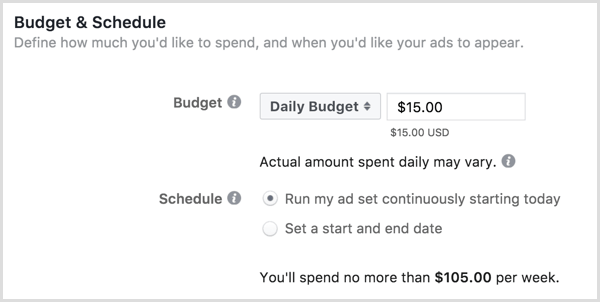
Not Refreshing Creative
Not refreshing creative is the biggest cause of ad fatigue. Even if you’re marketing to the same audience, do an updated round of creative. It can go a long way toward preserving your audience’s patience.
Poor Audience Targeting
The third type of ad fatigue is the hardest to identify and address. Most likely you’re targeting several audiences to reach potential customers. You might have a retargeting audience, a group of interests, and a lookalike audience based on additional indicators. The problem is that none of these groups is mutually exclusive. A single person could potentially be in all three groups at once.
A person might have visited your site, had the interests you’re targeting, and was put in your lookalike audience by Facebook. If you don’t take any action, this person could see your ad three times as often as someone in only one of the audiences.
Preventing audience overlap takes some planning, the use of a few handy tools, and patience, but it can make a big difference in campaign performance. Here are some steps you can take to overcome one person being in multiple audiences and having the potential to see multiple ads.
#1: Assess Overlap Potential of Custom Audiences
Start by building your target audiences as you would your other campaigns. If you set up your target audiences during the campaign creation in Power Editor or Ads Manager, click the Save This Audience button when you’re done.

If you’re feeling adventurous, you can create audiences directly with the Audiences tool and save some back and forth. In Business Manager, click the top navigation and then click Audiences under Assets. You may need to hover over the All Tools link near the bottom to see the full menu.
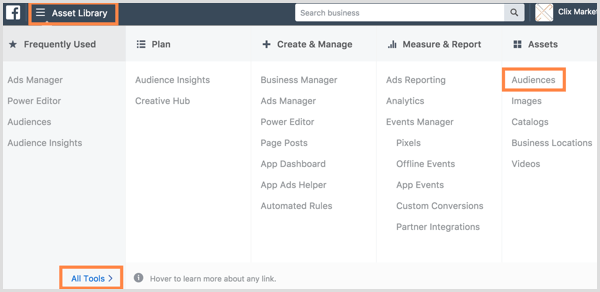
Once there, you can create any type of audience you want for your campaigns and it will be saved on this page.
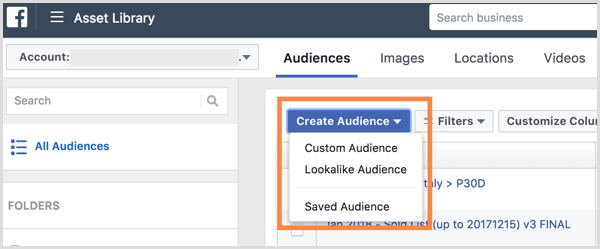
After you set up your audiences, the next step is to see how much overlap potential you’ve created. Select the boxes for up to five audiences you want to check for overlap. Then click the Actions drop-down menu and select Show Audience Overlap.
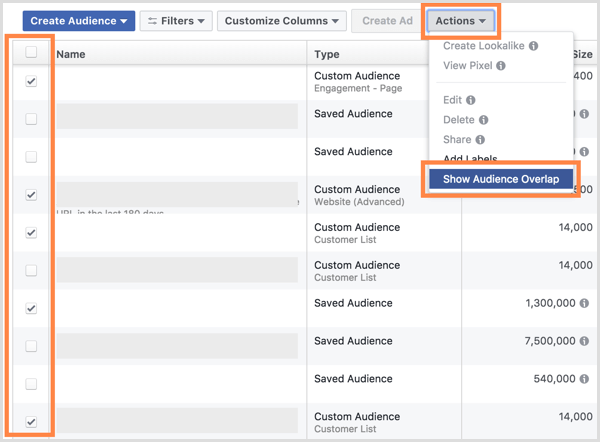
Depending on the number of audiences you’ve chosen, you’ll see a number of Venn diagrams and a percentage of overlap among your audiences.
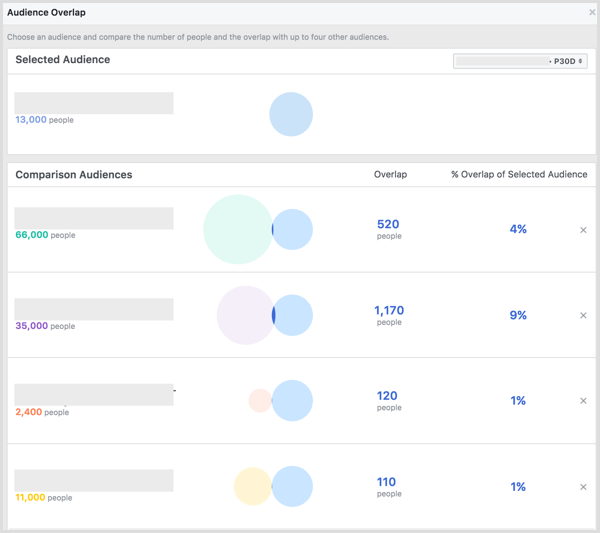
Each row shows the number of users in both audiences and the percentage of overlap potential with the audience at the top. If you select a different audience from the drop-down list at the top right, you’ll change the numbers in each row because all audiences are compared to the audience at the top.
Based on the results above, the audiences have anywhere from 1% to 9% overlap. While that might not seem like a lot, this type of problem can compound over time.

Keep in mind that this tool shows overlap between only two audiences at a time, so there’s still potential for a user to be in more than two of these audiences. If you’re seeing some overlap between two audiences, odds are you have potential for more than that.
#2: Prioritize Custom Audiences by Goal or Size
Based on the analysis above, there’s potential for overlap in the selected audiences. Now you need to take steps to reduce the impact on your campaigns. Put your audiences in order of priority. Which audiences are most important? Which do you want to be as untouched as possible? There’s no right or wrong answer. Everyone’s business relies on different indicators.
An ecommerce shop might think someone who has made a purchase from their website is a higher priority than someone who simply fits a persona. A site trying to generate leads might prioritize someone with a certain income level over someone else.
There are all kinds of situations where one audience might take priority over another. Whatever you decide, it’s important to put all of your audiences in order of highest to lowest priority.
If you can’t decide how to prioritize your lists, do it by size. Let’s look at these audiences as an example:
- Retargeting to previous visitors: 15,000
- Lookalike audience of customers: 2,100,000
- Interest targeting: 60,000

Each audience could yield a customer, but nothing ensures that someone won’t fit into more than one. If you prioritize by smallest size, you get the following order:
- Retargeting to previous visitors: 15,000
- Interest targeting: 60,000
- Lookalike audience of customers: 2,100,000
This prioritization will let you see which audiences are performing well and give smaller audiences their day in the sun. It also will ensure smaller audiences aren’t swallowed up by the lookalike audience.
#3: Use Exclusion Targeting to Remove Overlap Segments From Custom Audiences
Once you’ve prioritized your audiences, the last step is to structure your ad sets with the proper targeting and exclusions to make that prioritization stick. To make this happen, you need to exclude the higher-priority audiences from the lower to ensure the higher priority is preserved.
Start with the highest-priority audience in the example above: retargeting. Exclude that audience from the interest and lookalike ad sets. By doing this, you’re saying anyone who fits into both the retargeting audience and the other two audiences will be served only in the retargeting ad group because that’s your highest priority.
For some visuals, here’s what the overlap potential looks like before you exclude:

And here’s what your exclusion rules would do:

Next, repeat the process but exclude the interest users from the lookalike audience. Here’s a before and after look:

If you find lists easier to follow, here are the exclusions by campaigns:

When you’re finished, users will be eligible for targeting in only one of your audiences, despite having started in multiple.
Conclusion
When building audiences in Facebook, it’s easy to get swept up in all of the potential ways to reach your target customers and build loads of audiences to market to. While working through that process, stop and think about your potential for overlap and how that can impact your campaigns. A little upfront strategizing can lead to better performance down the road.
What do you think? Have you had trouble with oversaturating your target audience? Have you looked into the audience overlap issue before? Please share your thoughts in the comments below.
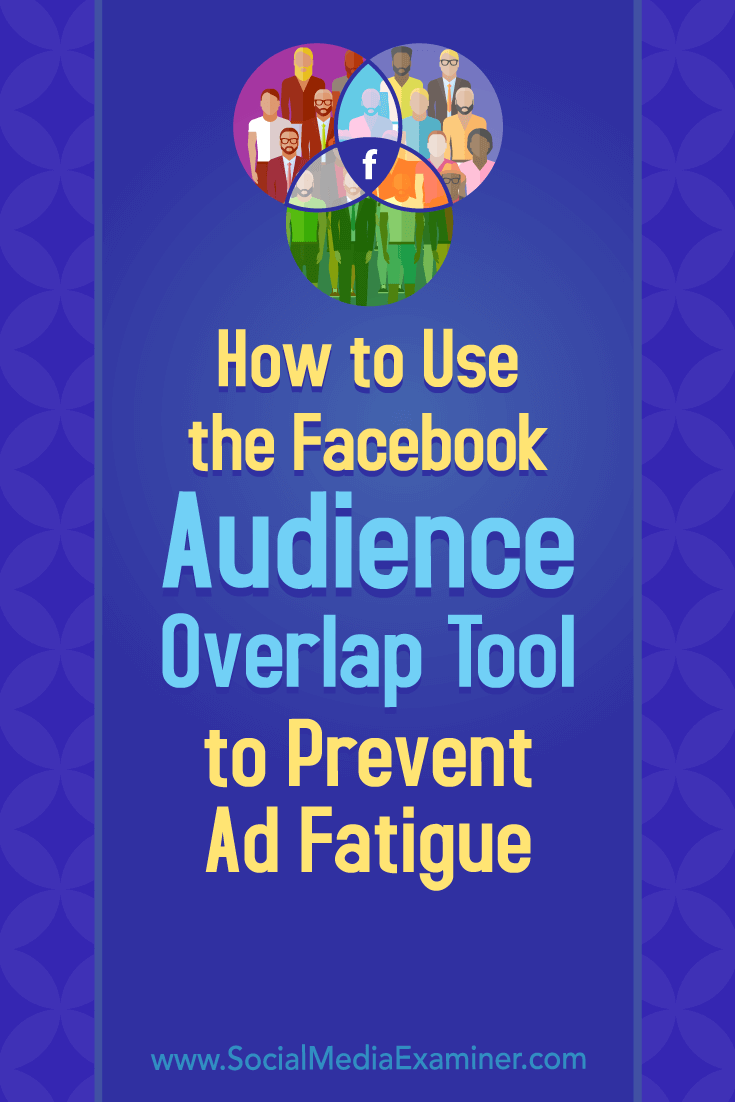
[ad_2]
source_link MMO mastermind



No comments:
Post a Comment